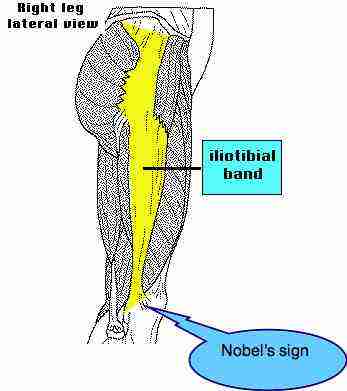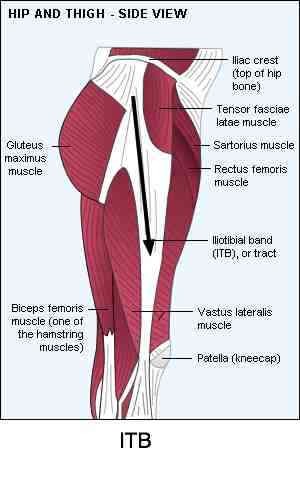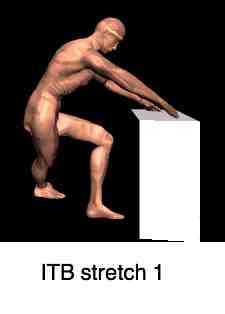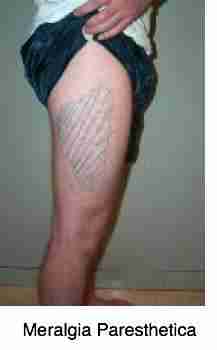- All You Need to Know
IlioTibial Band Stretch
The iliotibial band stretch is to help correct pain that runs from the side of the hip, down the thigh to the lateral knee.
This page was last updated by Dr Barrie Lewis on 5th July, 2019.
ITB - what is it?
This is an integral part of the treatment of the so called ITB syndrome , as is the correction of any sacroiliac fixations that frequently accompany this condition.
So many people who have had unsuccessful complete hip replacement also have severe pain radiating down the ITB with active trigger points in the TFL muscle, and a positive Noble's sign.
The Iliotibial band is really a broad tendon that runs down the side of the thigh from the Tensor Fascia Lata muscle, but it is also intimately connected to the gluteus muscles.
The origin of the ilio tibial band, ITB, is on the side of the large iliac bone, the large bone in the pelvis, actually what is called the crest, but no matter, and ends on the side of the knee at what is called the lateral condyle of the tibia, lower leg.
Because it has fibres connecting to the capsule of the hip, it may also cause pain in the groin. Other common causes of groin pain are hip arthritis, the cam and pincer impingement syndromes, hip dysplasia and Maigne's syndrome. And of course a hernia in the groin, and many other medical conditions.

IlioTibial Band Stretch
What is the function of the iliotibial band?
These pelvic muscles and the ITB have an important stabilising effect on the pelvis, especially when standing on one leg, as in kicking a soccer ball, but of course also in running, as the ITB is also a very important stabiliser of the knee.
Who gets ITB syndrome?
Anybody can suffer from ITB syndrome, but classically it is athletes who come forward for treatment as the iliotibial band is so important in stabilising the hip and knee whilst running but it occurs in all ages.
Elderly women particularly if they are slightly obese, are prone to bursitis of the Tensor Fascia Lata and gluteus muscles in the area around the lateral femoral trochanter. Iliotibial band stretch for this particular group is difficult as you will see at the end of this page. The condition is often aggravated to a too hard mattress.

A temporary solution is to take four pillows, lay them across the bed, and sleep on the pillows. If this definitely makes a difference, then a softer mattress is in order. Or a thin layer of foam placed over your usual mattress.
Cyclists too are particularly prone, particularly if they persist in riding with the feet toed in. The pain can be on the side of the hip, in the groin, mid thigh and frequently on the side of the knee. Clearly, there is overlap with other syndromes.

Causes
There is no substitute for a thorough history and a careful
examination as there are so many potential causes of the ITB. They can
be related to training habits, for example poor warmup or cooldown
procedures, or always running on a cantered road, particularly if there
is an associated short leg on the low side of the road; for example, running on the
right shoulder of the road plus a short right leg. Correct function of
the foot and ankle, the sacroiliac joints and the hip can either be the
main cause or contribute to the misery of this condition. Worn running
shoes, the causes are legion.
As stated earlier, weight gain places stress on the pelvis, thus it is not only obese women but also in pregnancy that pain in the ilio tibial band may occur, probably due to increasing instability in the pelvis. Iliotibial band stretch is vital part of the treatment in all groups.
A careful and thorough examination of the pelvis and whole lower limb is mandatory.
Noble's test is used to reproduce the pain in iliotibial
band tendonitis. With the patient in a supine position, the physician
places a thumb over the lateral femoral epicondyle as the patient
repeatedly flexes and extends the knee. Pain symptoms are usually most
prominent with the knee at 30 degrees of flexion. Comparing sides is important as it's a tender spot anyway.
The importance of Noble's test is that it enables the clinician to distinguish between a meniscus injury and iliotibial band pain, should McMurray's test be dubious. In fact, an ITB syndrome causing pain on the side of the knee often accompanies other lower leg and knee conditions. Even for proven osteoarthritis and meniscus pain, the itb should always be first considered, as there remains considerable doubt as to the effectiveness of arthroscopy knee surgery.
The treatment thus is also varied, depending on the findings.
In the short term, sport should be curtailed or even stopped for a period. Often change to another activity will prevent you from going crazy. For example, take up swimming for a few weeks if you are a runner. Or even cycling, though this could contribute.
Icing over the tender nodules and iliotibial band stretch and the glutes and any other joints that may be involved, the sacroiliac for example, is vital.
Treatment is usually required if the pain doesn't respond to your home remedies with a few weeks. You are unable to correct the fixation in the ankle mortice or sacroiliac joint for example. Guidance on stretches, leg length, whatever your chiropractor finds.
Strengthening of any weak muscles found, often the abductors is important.
Start
training on short distances, for runners on level, soft ground rather
than on roads, for example. Should runners find that the pain in the leg
returns with running, or cycling, then one important simple test is to
check the pulses in the lower leg, to rule out leg pain due to intermittent claudication.
Likewise in the older person, iliotibial band stretch will be important,
and weight loss should that be necessary. Between a rock and a hard
place, the older person in pain cannot exercise, and puts on weight.
In pregnancy, the management of the pelvis is vital. A sacral, or iliac subluxation is usually the underlying problem. There are many gentle treatments now that chiropractors use in the management of pain in the elderly and the pregnant woman with leg pain.
Maigne's syndrome
Because Maigne's syndrome, a high lumbar facet syndrome, also refers pain to the lateral buttock and thigh, and sometimes the groin, it too should be considered in every case of ITB pain.
Lateral thigh pain is a complex subject as seen in this Maigne's syndrome casefile.
Google appears to frown on too many links, so phrases in bold, like that above, need to be copied and pasted into the Site Search function in the navigation bar on your left if you want more information.
Meralgia paresthetica
Another condition producing lateral thigh pain is Meralgia Paresthetica where the nerve is trapped in the groin; the iliotibial band stretch might increase the numbness.
ITB Stretching
Because it is such a long tendon, stretching the ITB is particularly difficult. The best method of iliotibial band stretch can put undue stress on the pelvic joints, and should be done with care and discretion.
The following pictures will help. What I advise is to really stabilise your whole body with your arms and shoulders over a desk, so that the whole torso is fixed, giving support to the pelvis. It doesn't help to stretch the ITB, should it aggravate the SI joints!


To find links to topics in bold like dual antiinflammatory drugs below use the site search function in the navigation bar on your left.
CHIROPRACTIC COALFACE
Mrs S is a 52-year old woman, currently under care. She has typical Tensor Fascia Lata pain, radiating down the iliotibial band. The pain started four years ago for no obvious reason, but was and is associated with a lumbar facet syndrome. Left lateral flexion is painful in the lower back.
A piriformis release two years ago brought no relief at all. In fact, the pain got worse. Astonishingly she is taking 10 analgesics per day, 70 per week! Worse she is taking dual antiinflammatory drugs a lethal Molotov cocktail of medication.
Whilst it's early days, only four Chiropractic Help treatments, she is down to 2-3 pills a day, and despite that she says the pain is at least 30-40% better. Vital are lower back exercises ITB stretches and ice for the pain.
USEFUL LINKS
Did you find this page useful? Then perhaps forward it to a suffering friend. Better still, Tweet or Face Book it.

